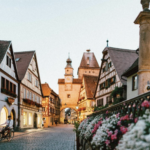Due to its young age and big size, luxury spending in China is unique. Despite China’s slowing economy in 2019, Chinese luxury spending is still growing. By 2025, Chinese luxury spending, which accounts for a third of global luxury spending, will double this decade’s figures, thanks to China becoming the country with the most high-income households worldwide. For luxury industries to handle these, they must understand how China’s rich people differ from luxury consumers around the world. It turns out that many international travelers who visit Asia are curious as well.

-
An international traveler’s question: Why are Asian people interested in luxury goods?
A study shows some differences between China’s rich and those in America. One difference is the age of rich people.
In China, 80% are under 45, while that age accounts for 30% of rich people in America.
The Chinese side also placed higher value on products’ functional benefits rather than their emotional benefits, which was the exact opposite of US consumers.
Besides, trust in foreign brands and trust in online advertising are both higher for Chinese people.
Studies find three factors that are unique to the rich Chinese person. The first is ‘value consciousness’ which means seeking the most value for a price. The second trait is the influence of social norms, as Chinese people are driven more by social needs than self-expression. The third trait is the need for uniqueness which is different from the first point.

-
Different categories of Asian consumers:
Upper class (22%) – At the top of the list is the highest-income group. Most of them live in big cities. In fact, this group has a higher percentage of women. As low-key ‘fashion-leaders’, they place value on luxury goods of the highest quality and are less concerned with brand names or displays of wealth, though they tend to be more brand-loyal. They are likely to pay top price for worthy products. They display behavior that shows more concern for health, environment and family safety than other groups. Their purchasing psychology is to be admired.
Demanding (13%) – These are the hardest working among the rich and the hardest to please. This group likes products that help them stand out from the rest and has a bigger desire to show off their purchases. They are less likely to pay top prices for the best products.
New rich (22%) – They are big spenders with an emphasis on brand names. They really want to boast about their purchases. Though they have lower annual incomes than the first two groups, their overall purchasing may amount to more in certain luxury industries. They seek value deals but are also willing to pay top price and are less concerned with health issues.
Elegant (14%) – A similar purchasing attitude to the ‘Luxuriant’ but with a lower annual income and a higher percentage of men. They are low-key, buy less, and care about quality more than a brand name. Yet they are brand-loyal. This group do not want to show off their purchases. They are happy to pay top prices.
Social climber (8%) – This smaller group has bigger numbers in smaller cities. They are influenced by the wealthier groups and try hard to socialize with the wealthiest in order to gain status. They are less confident and less likely to spend on luxury goods that are not necessities. They are price-conscious, seeking the cheapest options.
Practical (10%) – These are younger and newer to the luxury lifestyle and have larger groups in small cities. They place value on family more than social life and even less value on high-end products. They are more confident but also feel more pressured. So, they prefer low-key but good products. This group are unwilling to pay more or show off. Hence, they tend to seek the cheapest options.
Passionate (11%) – Mostly in small cities, they are the lowest income among the rich. Yet their buying habits show a desire to spend more than they can afford. They like to show off luxury things that help them stand out. They want to pay a high price if it means getting to show off something. They like big brand names, but are not limited to just a few brands.
“Besides differing from other countries’ rich people, China’s luxury buyers also differ greatly from each other. Many luxury brands have learned the hard way that marketing approaches that worked elsewhere in the world do not work in China. Also, the quantity of rich people in China means the word ‘rich’ cannot label them. Different people have different patterns. By looking at rich Chinese in a specific way, brands can make more money.”










